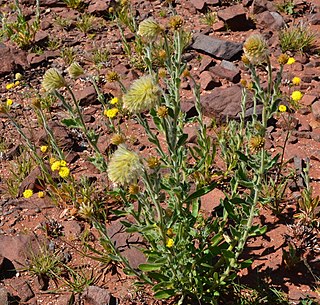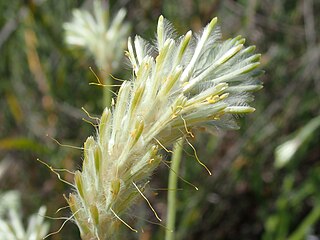
Ptilotus is a genus of approximately 125 species of flowering plants in the family Amaranthaceae, and is endemic to Australia, apart from Ptilotus conicus that also occurs in Malesia. Plants in the genus Ptilotus are annual or perennial herbs or shrubs with usually hairy spikes of compact spherical, oval or cylindrical flowers.

Ptilotus clementii, commonly known as tassel top, is a native Australian annual herb growing to between 0.3 and 1 metre high. Nodding, green flower spikes are produced between March and November in the species' native range.

Caladenia elegans, commonly known as the elegant spider orchid, is a species of orchid endemic to a small area near the coast of the south-west of Western Australia. It resembles the common spider orchid and often grows with it but its flowers are a different colour and C. elegans usually grows in poorly-drained soils. Only about 2,300 plants remained in 2016.

Pimelea serpyllifolia, commonly known as thyme riceflower, is a species of flowering plant in the family Thymelaeaceae and is endemic to southern Australia. It is an erect shrub with narrowly elliptic to spatula-shaped leaves, and compact heads of 4 to 12 yellow, yellowish-green or white flowers surrounded by 2 or 4 leaf-like involucral bracts. Male and female flowers are borne on separate plants.

Persoonia brevirhachis is a species of flowering plant in the family Proteaceae and is endemic to the south-west of Western Australia. It is an erect, often spreading shrub with smooth, compact bark, mostly narrow spatula-shaped to lance-shaped leaves with the narrower end towards the base and yellow to greenish yellow flowers borne singly or in pairs in leaf axils.
Persoonia spathulata is a species of flowering plant in the family Proteaceae and is endemic to the south-west of Western Australia. It is an erect to spreading shrub with hairy young branchlets, spatula-shaped leaves, and yellow flowers arranged singly or in pairs on a rachis up to 2 mm (0.079 in) long that continues to grow after flowering.
Persoonia manotricha is a species of flowering plant in the family Proteaceae and is endemic to Western Australia. It is an erect shrub with hairy young branchlets, more or less cylindrical leaves and greenish yellow flowers in groups of up two to eight on a rachis 2–15 mm (0.079–0.591 in) long. It is similar to P. bowgada and P. hexagona but has longer pedicels than P. bowgada and differently grooved leaves from P. hexagona.
Grevillea rogersoniana, commonly known as Rogerson's grevillea, is a species of flowering plant in the family Proteaceae and is endemic to a restricted area near Shark Bay in Western Australia. It is an erect shrub with spatula-shaped leaves with 3 to 5 teeth or shallow lobes on the end, and cylindrical clusters of reddish pink flowers, the style with a cream-coloured tip.

Ptilotus pyramidatus, the pyramid mulla mulla, is a small white herb in the family Amaranthaceae.

Ptilotus polystachyus is a perennial herb in the Amaranthaceae family.
Goodenia granitica is a species of flowering plant in the family Goodeniaceae and endemic to the south-west of Western Australia. It is an annual herb with spatula-shaped, sometimes lobed leaves, in a rosette at the base of the plant, and racemes of yellow flowers.
Olearia occidentissima is a species of flowering plant in the family Asteraceae and is endemic to the extreme west of Western Australia. It is an erect or prostrate, wind-pruned shrub with narrowly elliptic leaves that are woolly-hairy on the lower surface, and white, daisy-like inflorescences.

Schoenia filifolia is a species of flowering plant in the family Asteraceae, and is endemic to the southwest of Western Australia. It is an annual herb with terete leaves and yellow, daisy-like inflorescences.
Ptilotus actinocladus is a species of flowering plant in the family Amaranthaceae and is endemic to inland Western Australia. It is a prostrate annual herb with a central stem and radiating lateral stems, linear to lance-shaped stem leaves, pink spherical or cylindrical spikes of flowers with long, silky hairs, and four fertile stamens.

Ptilotus aervoides, commonly known as mat mulla mulla, is a species of flowering plant in the family Amaranthaceae and is endemic to western Australia. It is a prostrate, mat-forming annual or short-lived perennial herb, its stems densely hairy at first, egg-shaped to spatula-shaped stem leaves, dense spikes of hairy creamy-green flowers with two or three fertile stamens.

Ptilotus albidus is a species of flowering plant in the family Amaranthaceae and is endemic to inland Western Australia. It is a compact perennial shrub with linear leaves, spherical spikes of white flowers and dull brown seeds.
Ptilotus andersonii is a species of flowering plant in the family Amaranthaceae and is endemic to a restricted area of Western Australia. It is a prostrate, hairy, perennial herb with a spatula-shaped to lance-shaped leaves at the base of the plant, lance-shaped cauline leaves, and pink, oval spikes of flowers with two fertile stamens.
Ptilotus angustifolius, commonly known as regal fox tails, is a species of flowering plant in the family Amaranthaceae and is endemic to South Australia. It is a low, bushy herb with a several stems, narrowly egg-shaped leaves at the base of the plant, oval, intensely fragrant spikes of purple flowers and cylindrical heads of many long, hairy fruits.

Ptilotus aphyllus is a species of flowering plant in the family Amaranthaceae and is endemic to the a small area of inland Western Australia. It is a leafless perennial, except when young, and spikes of purple flowers fading to pink and pale orange.

Ptilotus appendiculatus is a species of flowering plant in the family Amaranthaceae and is endemic to the north of Western Australia. It is a prostrate perennial herb with egg-shaped leaves and spikes of pink flowers.











